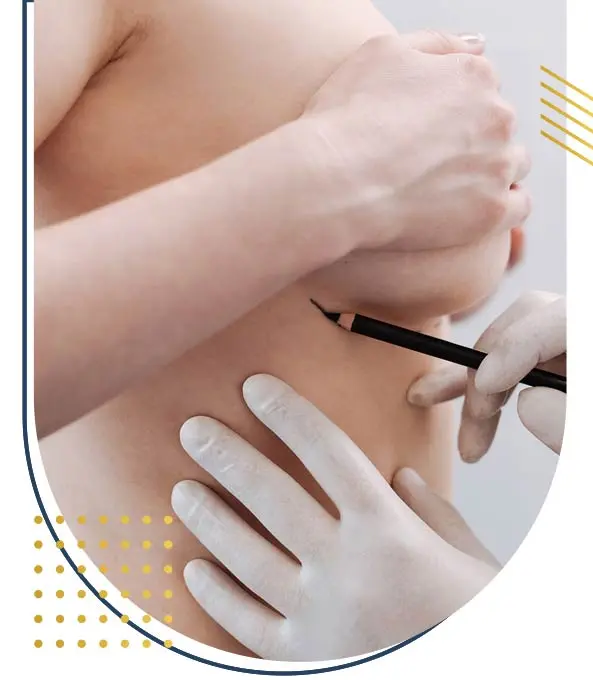
In the Egyptian society, keeping up appearances is a very important thing. Since the times of ancient Egypt, beauty is considered as a sign of royalty and power. Even nowadays, it is still seen as such. We witness it every day in Television and on the internet.
For a woman, one of the important parts in her body is the breasts. Source of many fantasies and seduction. Many of these individuals are searching to improve the looks of their breast by medical interventions.
Among the various kind of aesthetic surgeries, Breast augmentation is known to be one, if not the most practiced in the world. Since its first apparition in 1895, performed by Dr.Vincenz Czerny, a German surgeon. This procedure knew an amazing amount of evolution and new techniques that improved the viability of its results.
What is Breast lipofilling ?
Breast Lipofilling in Egypt, also known as fat transfer breast augmentation, is an aesthetic surgery consisting in the transfer of autologous fat, which means from the body of the patient, to the breasts. This procedure is used in order to increase their volume and modify their shape.
It is considered as a relatively successful surgery. Known to be a reconstructive surgery to the cases of breast hypotrophy. An insufficiency in the breast development related to the women morphology.
The Breast Lipofilling in Egypt is destined to women who are fully grown. This way, to ensure that there is no further physical development. The minimal age for it is 18 years old.
What are the types of the Breast lipofilling procedure ?
Traditional Breast Lipofilling :
Traditional breast lipofilling, also known as autologous fat transfer or fat grafting, is a surgical procedure designed to enhance breast size and shape using the patient's own fat cells harvested from other areas of the body, such as the abdomen, thighs, or buttocks.
This technique involves multiple steps, beginning with the extraction of excess fat via liposuction from the donor site. The harvested fat cells are then processed and purified to remove impurities and excess fluids before being meticulously injected into the breasts to achieve the desired volume and contour.
Traditional breast lipofilling is favored by many patients seeking a natural-looking and long-lasting alternative to breast implants, as it utilizes the body's own tissues without the use of foreign materials.
Additionally, because the fat cells are sourced from the patient's own body, the risk of allergic reactions or rejection is minimal. However, it's important to note that not all of the transferred fat cells may survive the transplantation process, and multiple sessions may be required to achieve optimal results.
Patients undergoing traditional breast lipofilling can expect some swelling, bruising, and discomfort in both the donor and recipient areas following surgery, but these side effects typically subside within a few weeks, revealing beautifully enhanced breasts with a softer, more natural feel.

Composite Breast Lipofilling :
Composite breast lipofilling, also known as composite breast augmentation, combines traditional breast lipofilling with the insertion of breast implants to achieve enhanced volume, shape, and projection. This technique is particularly suitable for patients with insufficient natural breast tissue or those seeking significant augmentation beyond what can be achieved with fat grafting alone.
The procedure begins with the extraction of excess fat from donor areas using liposuction, followed by the purification and processing of the harvested fat cells. In addition to fat transfer, breast implants are carefully inserted into the breasts to provide additional volume and support, resulting in a fuller, more contoured appearance.
Composite breast lipofilling offers the benefits of both fat grafting and breast implants, allowing for customizable results that combine the natural look and feel of autologous fat with the added volume and projection provided by implants.
Patients undergoing composite breast lipofilling can expect a longer recovery period compared to traditional fat grafting alone, as the insertion of implants requires additional surgical manipulation and incisions.
However, the results are often well worth the investment, with beautifully augmented breasts that look and feel natural.
Stem Cell-Enriched Breast Lipofilling :
Stem cell-enriched breast lipofilling, also known as stem cell-assisted lipotransfer, is an innovative technique that harnesses the regenerative properties of stem cells to enhance the outcomes of traditional breast lipofilling procedures. Stem cells, which are undifferentiated cells capable of differentiating into various cell types, including fat cells, are harvested along with adipose tissue during the liposuction process.
These stem cells are then concentrated and combined with the purified fat cells before being injected into the breasts, where they promote tissue regeneration, improve vascularity, and enhance fat cell survival. Stem cell-enriched breast lipofilling offers several potential advantages over traditional fat grafting alone, including increased fat retention, improved tissue integration, and enhanced aesthetic outcomes.
Additionally, because stem cells are sourced from the patient's own body, there is no risk of rejection or allergic reaction.
While stem cell-enriched breast lipofilling is still considered a relatively new and evolving technique, early clinical studies have shown promising results in terms of improved fat survival rates and enhanced breast augmentation outcomes. However, further research is needed to fully understand the long-term benefits and safety profile of this innovative approach.
External Expansion Assisted Breast Lipofilling :
External expansion assisted breast lipofilling is a specialized technique that combines traditional breast lipofilling with the use of external tissue expansion devices to enhance the outcomes of fat grafting procedures.
Tissue expansion involves the gradual stretching of the skin and underlying tissues using external devices such as inflatable tissue expanders or negative pressure systems. By creating a larger space within the breast tissue, external expansion devices facilitate the accommodation of a greater volume of transferred fat cells, resulting in improved fat cell survival and enhanced breast augmentation outcomes. This technique is particularly beneficial for patients with limited breast tissue or skin laxity, as it allows for the creation of a more accommodating and supportive environment for fat grafting. Additionally, external expansion assisted breast lipofilling can help minimize the risk of complications such as capsular contracture and implant malposition, as it promotes the natural integration of transferred fat cells with surrounding tissues.
While external expansion assisted breast lipofilling may require a longer recovery period compared to traditional fat grafting alone, the results are often well worth the investment, with beautifully augmented breasts that look and feel natural.
Sequential Breast Lipofilling :
Sequential breast lipofilling is a progressive approach to breast augmentation that involves multiple stages of fat grafting performed over several sessions. This technique is particularly suitable for patients seeking gradual, subtle enhancements to their breast size and shape or those with limited donor fat available for a single procedure.
The procedure begins with the extraction of excess fat from donor areas using liposuction, followed by the purification and processing of the harvested fat cells.
A portion of the purified fat cells is then injected into the breasts during the initial session, with subsequent sessions scheduled at regular intervals to add additional volume and contouring as desired.
Sequential breast lipofilling allows for a more gradual and controlled augmentation process, allowing the surgeon to fine-tune the results over time and achieve a more customized outcome.
Additionally, by spacing out the fat grafting sessions, patients can minimize the risk of overcorrection or irregularities and ensure optimal fat cell survival and integration with surrounding tissues. While sequential breast lipofilling may require multiple treatment sessions to achieve the desired results, the gradual nature of the procedure can lead to beautifully enhanced breasts with a natural-looking and long-lasting outcome.
Revision Breast Lipofilling :
Revision breast lipofilling, also known as secondary or corrective breast lipofilling, is a specialized technique used to address asymmetry, contour irregularities, or other aesthetic concerns following previous breast augmentation procedures. Whether due to implant malposition, capsular contracture, or changes in breast appearance over time, some patients may require revision surgery to achieve their desired outcome.
Revision breast lipofilling involves the careful extraction of excess fat from donor areas using liposuction, followed by the purification and processing of the harvested fat cells. The purified fat cells are then strategically injected into the breasts to correct asymmetry, improve contour irregularities, or enhance overall breast appearance.
This technique offers a minimally invasive alternative to traditional revision breast surgery, allowing for targeted improvements with reduced risk of complications and downtime. Additionally, because revision breast lipofilling utilizes the patient's own fat cells, there is no risk of allergic reactions or rejection, making it a safe and effective option for patients seeking to refine their breast appearance following previous augmentation procedures.
Hybrid Breast Augmentation :
Hybrid breast augmentation is a combination technique that integrates breast implants with fat grafting to achieve customized and natural-looking breast enhancement results. This approach combines the benefits of both breast implants and autologous fat transfer, allowing for enhanced volume, shape, and contouring with a reduced reliance on implants alone. The procedure begins with the extraction of excess fat from donor areas using liposuction, followed by the purification and processing of the harvested fat cells.
A portion of the purified fat cells is then strategically injected into the breasts to augment volume, improve contour, and enhance overall breast appearance. In addition to fat grafting, breast implants are carefully inserted into the breasts to provide additional volume, projection, and support. Hybrid breast augmentation offers several potential advantages over traditional breast augmentation techniques, including a more natural-looking and feeling outcome, reduced risk of implant-related complications such as capsular contracture, and improved overall aesthetic results.
By combining the benefits of fat grafting with the structural support provided by implants, hybrid breast augmentation allows for customized enhancements that can be tailored to each patient's unique anatomy and aesthetic goals.
How is Breast lipofilling surgery in Egypt done ?
First of all, before performing the surgery, a preparation must be done. The surgeon gives the patient a number of medical check-ups. This will give the doctor the necessary information to ensure the success of the procedure.
The Breast lipofilling surgery is performed in two major steps, and under general anaesthesia. The first one is the extraction of fat cells. This step consists in the surgeon identifying all of the potential area where he will be able to collect the autologous fat.
The important part in this step, is the identification of the viable and usable cells. This is done during the liposuction procedure in which the fat will be extracted from the selected area that contains an excess in fat.
Once the fat cells are collected, they need to be separated from the other tissues that don’t need to be injected with them. This step is done with a sterile centrifugation, which will generally take a while depending on the situation. That’s one of the reasons why the breast lipofilling surgery lasts that long.
After that, the second major step starts. The injection of fat cells in the target area. It is done by making a small incision, through which the autologous fat is injected. The surgeon maximizes the filling area by making the injection in as many angles and directions.
The procedure takes up 30 to 120 minutes, depending on the amount of fat transfer and the patient situation.
What to expect after a fat transfer breast augmentation in Egypt ?
The recovery process lasts around five days. During this time, moderate pain are felt. The appearance of edema as well as bruising is not something weird, but totally normal. This will disappear in the following two weeks.
After the surgery, expect a hospitalization period of 24 hours up to 48 hours, depending on the surgeon decision.
What are the results after a breast lipofilling in Egypt ?
The results of the procedure can be visible immediately after the surgery. But the final result is obtained only after three to six months. The advantage that this surgery provides, natural looking breasts and the relatively safe technique that is used.
Some patients may encounter some breast volume loss. This is normal, because it requires a couple of sessions to achieve a lasting result.
The price of a breast lipofilling in Egypt :
The price of breast lipofilling in Egypt is advantageous, you will be able to have a high quality medical stay. Ask for a free quote to obtain breast lipofilling Egypt cost.
What are the risks of the Breast lipofilling procedure ?
Infection :
As with any surgical procedure, there is a risk of infection following breast lipofilling. This risk is typically minimized by adhering to strict sterile techniques during the procedure and prescribing antibiotics to reduce the risk of post-operative infection.
However, if an infection does occur, it may require additional treatment such as antibiotic therapy or, in severe cases, surgical intervention to drain the infected area.
Asymmetry :
Despite meticulous surgical technique, there is a risk of asymmetry following breast lipofilling. This can occur due to differences in fat absorption or distribution between the breasts. In some cases, additional touch-up procedures may be necessary to correct asymmetry and achieve optimal results.
Fat Necrosis :
Fat necrosis is a rare complication that occurs when the transferred fat cells do not survive and become hardened within the breast tissue. This can lead to the formation of lumps or areas of firmness within the breast.
While fat necrosis typically resolves on its own over time, it may require additional treatment if symptoms persist.
Calcification :
In some cases, calcifications may develop within the breast tissue following breast lipofilling. These calcifications are typically benign and do not require treatment, but they may be detected on mammograms and require further evaluation to rule out any underlying concerns.
Hematoma and Seroma :
Hematoma refers to the accumulation of blood within the breast tissue, while seroma is the buildup of fluid. These complications can occur following breast lipofilling and may require drainage to prevent infection or other complications.
While the risk of hematoma and seroma is relatively low, it is still important to monitor for signs of these complications during the post-operative period.
Changes in Sensation :
Some patients may experience temporary or permanent changes in sensation in the breasts or nipples following breast lipofilling.
This can manifest as numbness, tingling, or altered sensitivity. While most changes in sensation resolve on their own over time, some patients may experience long-term alterations in sensation.

Capsular Contracture :
While less common than with breast implant surgery, there is still a risk of capsular contracture following breast lipofilling. This occurs when scar tissue forms around the transferred fat cells, causing the breasts to feel firm or hardened. In severe cases, capsular contracture may require additional treatment such as surgical intervention to release the scar tissue.
Delayed Wound Healing :
Some patients may experience delayed wound healing following breast lipofilling, particularly if they have underlying medical conditions such as diabetes or vascular disease. This can result in prolonged swelling, bruising, or discomfort and may require additional monitoring and wound care.
Unsatisfactory Results :
While breast lipofilling can achieve natural-looking and long-lasting results for many patients, there is always a possibility of unsatisfactory outcomes. Factors such as inadequate fat graft survival, asymmetry, or unexpected changes in breast appearance may occur despite careful planning and execution of the procedure. In such cases, additional procedures or revisions may be necessary to achieve the desired aesthetic outcome.

